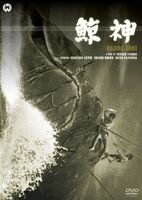| Kujira Gami | |

| |
|---|---|
| Directed by | Tokuzō Tanaka |
| Produced by | Masaichi Nagata |
| Written by | Kaneto Shindo |
| Starring | Kojiro Hongo Takashi Shimura |
| Music by | Akira Ifukube |
| Cinematography | Setsuo Kobayashi |
| Distributed by | Daiei |
| Released | July 15, 1962 |
| Running time | 100 minutes |
| Budget | ¥???,???,??? |
| Gross revenue | ¥???,???,??? |
| Country | Japan |
| Language | Japanese |
Kujira Gami (鯨神 Kujira Gami?, lit. Whale God) is a 1962 Japanese daikaiju eiga (giant monster movie) about a giant whale named Whale God. The film is similar in nature to the popular Mothra film and is also the second giant monster film from Daiei.
Kujira Gami opens with a small fishing village being terrorized by a seemingly unkillable whale. Shaki, whose family has been destroyed by the animal's rampage, becomes obsessed with killing it. Meanwhile, a brutal drunkard comes to the village, intent on killing the whale himself.
Plot[]
When Japanese Fishermen have long fought with the giant whale, like the incarnation of the devil, but hundreds have lost their lives. Now called the "whale god", he is afraid and no one tries to approach him. However, Shaki, who was born in Wadaura, Kyushu, vowed to defeat the whale god with his own hands after his grandfather, father and brother were killed. The whale owner of the village has declared that he will give the murderer of the whale god his only daughter, Toyo, and the name of the house. After Shaki, the person who called himself "I am--" was a man who had just arrived from Kishu. Ai, who secretly loves Shaki, is worried that Shaki will marry Toyo, but Shaki's only purpose is to defeat the whale god. In the winter, when Kasuke wants to go to Nagasaki and become a doctor, he asks Shaki's younger sister Yuki to marry him. Shaki didn't object because he was going to die. On the day the plum blossoms bloomed, Ray gave birth to a baby in a cave on the coast. Knowing that he was not his own child, Shaki decided to become a father. I loved rays from the bottom of my heart. Eventually, there was a communication that the whale god was coming to Wadaura at full speed. The day before the departure, Kishuo urged me to "sit the most blade stab", but Shaki did not respond. The nine ships and the two Futami ships left the beach all at once and headed for the whale god. Dozens of harpoons were thrown into the back at the signal of "Harpoon!" The injured whale god swims offshore at a tremendous speed. At that time, Kishu man jumped into the sea of blood. The whale head hugged Shaki. The Kishu man jumped on the back of the whale god and scooped out the key points with a spear. The Kishu man was dead when the whale god who dived in suffering resurfaced. Shaki clung to his monster-like head and wielded a knives on his nose. Blood spouted like a waterfall, and the sea was dyed vermilion. The whale god died, but Shaki was also seriously injured. Shaki, who entered the sleeping coffin on the sandy beach, confronted the whale god. There he learned for the first time that his child's father was a Kishu man and had taken such reckless behavior to help himself. As the setting sun dyed the sea, the end of Shaki was approaching. Shaki, who loved the whale god above all, felt that he had transformed into a whale god ...
Monsters[]
Cast[]
- Katsu Shintaro as Kishu
- Kyoko Enami
- Kichijiro Ueda
- Koji Fujiyama
- Kojiro Hongo as Shaki
- Bontaro Miake
- Fujimura Shiho as Ei
- Reiko Fujiwara as Okoma
- Michiko Takano as Yuki
- Takemura Yosuke as Kasuke
- Takashi Shimura as The Village elder
Video releases[]


7-16(金)公開「妖怪・特撮映画祭」上映~『鯨神』予告篇~
Trailer
- It was released as video software by Daiei Video in 1984.
- It was made into DVD software in 2006, and a low-priced DVD was released in 2014.
- Was released from the 2014 "bi-weekly Daiei special effects movie DVD Collection" (De Agostini, but launch in) * had been planned, it was removed from the lineup at the time series extension of 2016.
Production[]
Filming and Editing[]
Filming is credited to Komatsubara, but it was actually managed by Toru Matoba. At that time, Daiei had a special effects pool at the Kyoto studio, so special effects were mainly shot in Kyoto. Fuminori Ohashi created the whale god and created a full-scale scale model with a total length of 30 meters and a 5.5-meter model at a huge cost of 8 million yen, but the modelling was excellent, but it hardly moved, and in the end, the alpine good idea to create a miniature, that was taken is almost at it. As a result, the full-scale model was used only for the entwined scene with the actor, and the 5.5-meter model was used only for the diving scene. In addition to that, special shooting like Daiei has been effective, such4 as animating a group of seabirds that are a precursor to the appearance of the whale god.
Steel Kojiro Hongo and Shintaro Katsu are riding on the back of a whale God, it was responsible for the animation synthesis tide cleaning was cut-and-paste.
